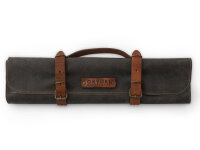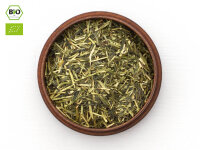Kanetsugu Cutlery, the knifemakers from Seki
The company Kanetsugu Cutlery was founded in 1949. It emerged from Kawamura Matsujiro & Co., which had been producing Japanese chef's knives since 1918. Both companies were managed by Matsujiro Kawamura. The tradition of the company goes back to the Nanboku-cho era (1336-1392) when a first Kanetsugu became a swordsmith. Mitsuyasu Kawamura became president of Kanetsugu in 1994 in the third generation. This makes Kanetsugu one of the knife producers with the longest family tradition in this trade. The company is based in Seki-City, the capital for knife production in Japan.
Knife series Zuiun
Material: cutting core of
SPG2, Super Powder Gold 2, manufacturer Takefu, Japan. Depending on the ratio, the steel is also called SGP2, Super Gold Powder 2. This steel is an absolute premium steel, which is very expensive and difficult to get even in Japan. It is a powder metallurgical high performance steel with a very fine structure. The high carbon content of 1.3% makes it extremely hard, so that up to 65
HRC are possible. Other components are 15% chromium, 3% molybdenum and 2% vanadium. With this cutting core, the Zuiun series knives offer exceptionally high sharpness, cutting performance and durability and even surpass the premium steel VG-10. The cutting core is covered by 62 layers of damask steel. The knife handle is made of hard-wearing and easy-care wood laminate, octagonal, with decorative metal decoration. The shape of the knives and the knife sharpening also deserve special attention. All Zuiun knives are slightly convex ground, which gives the blades stability, durability and an extremely pleasant cutting action. The Kanetsugu Cutlery derives this cut from the traditional Japanese swords, which the swordsmith Kanetsugu forged in the 14th century. The knifemakers from Seki are known for their consistent combination of traditional manufacturing methods with high-tech, both in the production and in the choice of materials. These Japanese chef's knives are therefore created like the famous Katana and, similar to the Samurai swords, offer exceptional sharpness and durability. Moreover, they are also easy to sharpen, thanks to this sharpening method.
Translated with www.DeepL.com/Translator (free version)
Instructions for use
After use please wash by hand with hot water. If necessary, use some neutral detergent. The knife should not be put in the dishwasher. Dry well after cleaning. Please keep the knife away from children. These knives are extremely sharp, please be careful. Japanese chef's knives are made of very hard steels and are forged thinner than European knives. Please make sure that no unnecessary forces - especially no lever forces - act on the blade, otherwise small chipping may occur in the blade. These may have to be ground out by a specialist. Leverage forces often occur when cutting deep-frozen material or bones. The knife should always be guided straight and cutting, without much pressure. To maintain sharpness, the knife should not cut on stone, glass or other hard surfaces. Never use "sharpening steel" for resharpening. We recommend using water grinding stones (grit: 400-800 for pre-sharpening, 1000 or considerably more for fine grinding).
blade type:
Gyuto, Chef's knife
Manufacture/Smith
Seki Kanetsugu Cutlery
Materials
Blade: Super Powder Gold 2, premium stainless steel, 62 layers of damascus steel /> Handle: wood laminate
blade hardness
63 - 64 HRC
Grinding
Ryo-ba (both sides)
Dimensions approx.
blade length: 205 mm
blade height: 45 mm
blade thickness: 2.2 - 0.5 mm
total length: 355 mm
weight: approx. 170 g
packaging
gift packaging wood box
Care
Clean by hand, no dishwasher. Dry thoroughly.





















